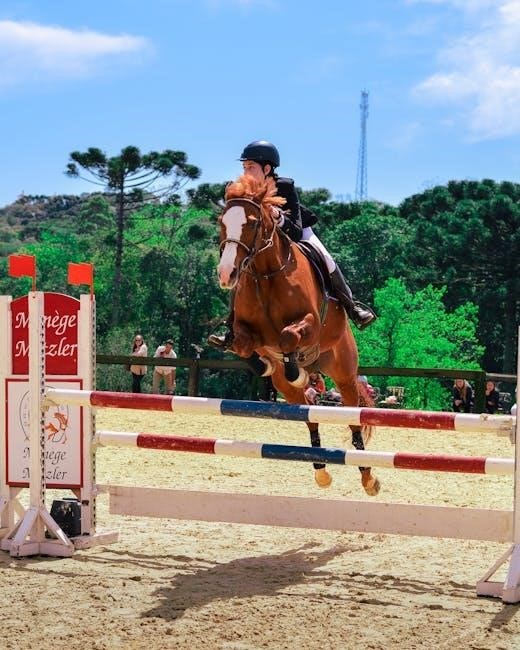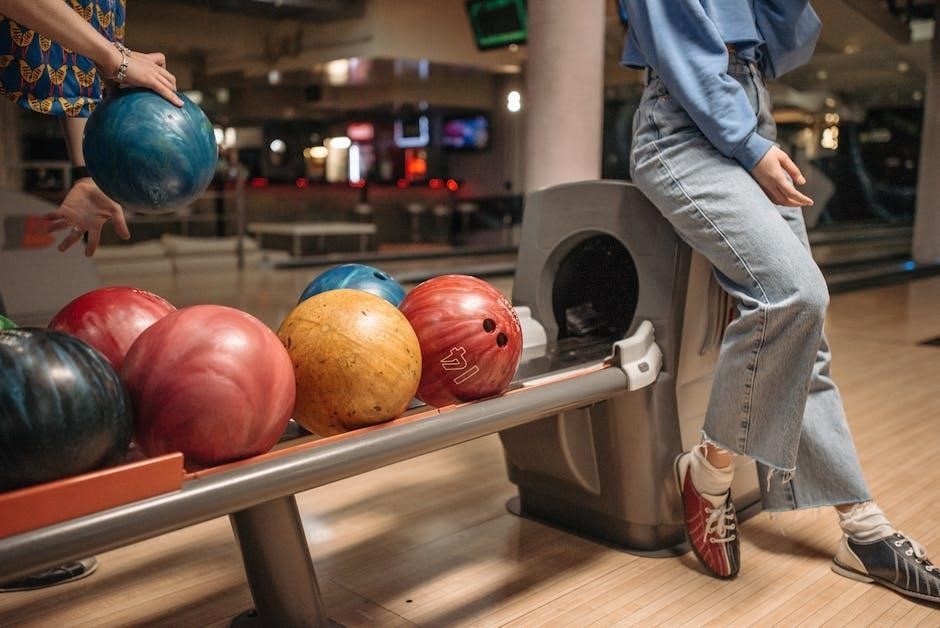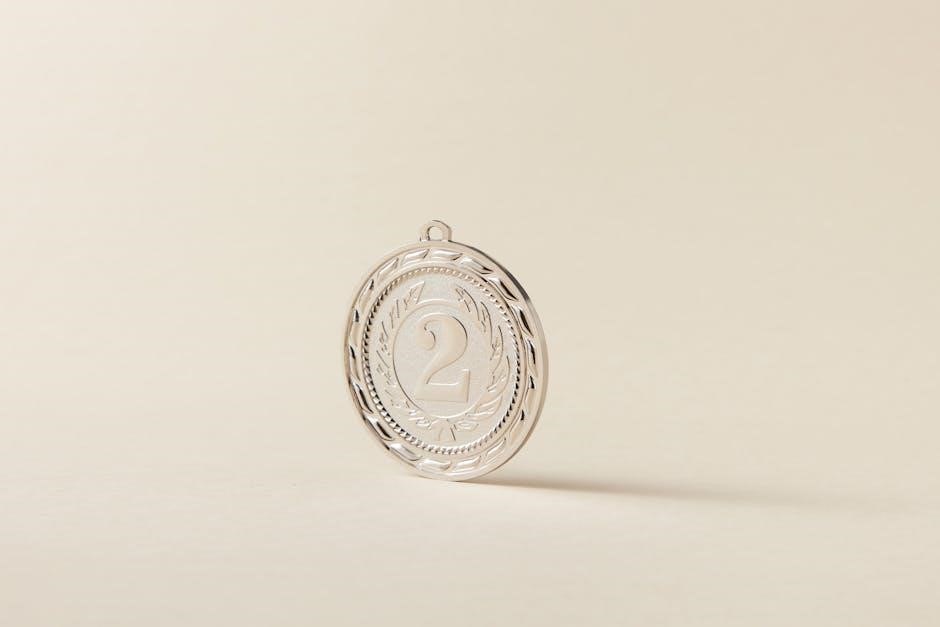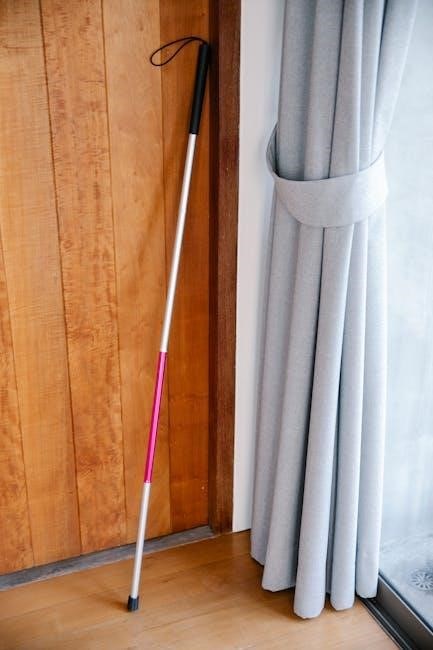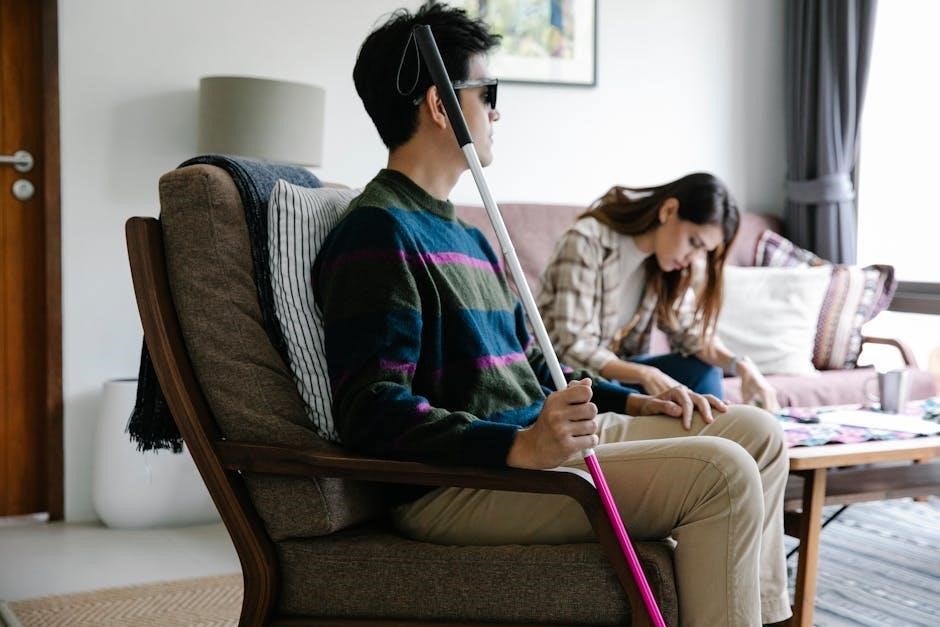Eyeshadow is a versatile makeup essential that enhances eye features and boosts confidence. With countless shades and techniques, it offers endless possibilities for natural to glamorous looks, making it a must-have in every makeup kit.
Why Eyeshadow is Essential in Makeup
Eyeshadow is a cornerstone in makeup routines, offering versatility to enhance and transform eye features. It adds depth, highlights, and defines eye shapes, creating a polished look. Whether subtle or dramatic, eyeshadow complements natural beauty and boosts confidence. Its wide range of shades suits every skin tone and personal style, making it a must-have for both everyday simplicity and glamorous occasions.
By blending colors, eyeshadow can create dimension, brighten the eye area, and frame the face. It’s a key tool for self-expression and artistry in makeup, allowing individuals to customize their look effortlessly. Thus, eyeshadow remains an essential element in every makeup collection.
A Brief History of Eyeshadow
Eyeshadow has a rich history dating back thousands of years, with its origins in ancient civilizations. In Egypt around 4000 BCE, malachite was used as a green eyeshadow, while kohl, a black powder, lined eyes for protection and beauty. Similarly, in ancient Greece and Rome, crushed minerals and natural pigments were applied to enhance eye features. During the Middle Ages, eye makeup declined in popularity but reemerged in the Renaissance. The 20th century saw eyeshadow evolve with modern formulations and diverse shades, becoming a staple in cosmetics. Its versatility and artistic appeal have made it a cornerstone of makeup artistry today.

Tools and Brushes for Eyeshadow Application
The right tools elevate your eyeshadow application. Essential items include fluffy base brushes, crease brushes, blending sponges, and flat packing brushes. Quality matters for smooth, lasting results.
Types of Eyeshadow Brushes
Choosing the right eyeshadow brushes is crucial for achieving professional results. A fluffy base brush is ideal for applying all-over color, while a crease brush is designed for precise application in the crease. A flat packing brush is perfect for pressing eyeshadow onto the lid for intense pigment. A blending brush, with its soft, fluffy bristles, is essential for creating seamless transitions between shades. Smaller detail or liner brushes are great for adding precise lines or detail work. Each brush type serves a specific purpose, and having a variety ensures versatility in your makeup looks.
Color Wheel for Eyeshadow Guidance
A color wheel is an essential tool for selecting harmonious eyeshadow shades. It helps identify complementary colors, which sit opposite each other on the wheel, creating striking contrasts. Analogous colors, found side by side, blend seamlessly for natural looks. Neutral tones like beige, taupe, and champagne work universally, while bold hues add drama. Understanding warm and cool undertones ensures shades complement your skin tone. For example, warm neutrals suit golden complexions, while cool tones enhance porcelain skin. Experimenting with the color wheel allows you to craft cohesive, professional eyeshadow looks tailored to your preferences and features, making it a valuable guide for both beginners and makeup enthusiasts.

Choosing the Right Eyeshadow
Selecting eyeshadow involves considering your skin tone, eye color, and personal style. Opt for shades that complement your features, ensuring a harmonious and flattering finish, while experimenting with textures and finishes to enhance your beauty and confidence.
Eyeshadow for Different Skin Tones
Choosing eyeshadow based on skin tone ensures a seamless, natural look. For fair skin, opt for light neutrals, soft pinks, and shimmery champagnes to brighten the eyes. Medium skin tones can pull off warm bronzes, earthy browns, and subtle golds, creating depth and dimension. Deep skin tones look stunning in rich jewel tones like emerald greens, berry shades, and metallic coppers, which enhance contrast and add vibrancy. Remember, undertones matter—cool tones pair well with purples and blues, while warm tones shine with golden and honey-based shades. Experimenting with textures and finishes can further elevate your look, ensuring it complements your unique complexion beautifully.
Eyeshadow for Various Eye Colors
Eyeshadow can enhance and complement different eye colors. For blue eyes, warm neutrals like champagne and gold create contrast, while cool tones like slate gray add depth. Brown eyes pair well with rich jewel tones, deep bronzes, and smoky shades, making them appear warmer. Green eyes sparkle with earthy tones, emerald greens, and purples, which accentuate their natural vibrancy. Hazel eyes benefit from a mix of warm browns, shimmery coppers, and soft charcoals to bring out flecks of gold or green. Experimenting with these shades can make your eye color stand out and add dimension to your look. Light shades on the brow bone can also brighten the area for a radiant finish.

Eyeshadow Application Techniques
Eyeshadow application techniques involve blending, layering, and precise brushwork to create stunning eye looks, transforming your features with every stroke.
Step-by-Step Guide for Beginners
Starting with a primer, apply a base shade across your lid for even color. Use a medium tone in the crease with a fluffy brush for depth. Highlight the brow bone with a light shade. Line your lash line for definition. Blend edges smoothly for a seamless look. Finish with mascara to enhance lashes. Practice makes perfect, so don’t be discouraged if it takes time to master. Remember, less product and gradual building yield the best results for a polished, everyday look.
Advanced Methods: Cut Crease and Smoky Eyes
For a cut crease, apply tape under your eye as a guide. Use a concealer to paint a sharp line, then fill with eyeshadow. Blend dark shades in the crease for depth. Smoky eyes involve layering dark and light shades, blending thoroughly. Start with a base color, add medium tones, then darken the outer corner. Blend upwards for a seamless transition. Line your eyes and smudge for softness. Finish with mascara for drama. These techniques create bold, eye-catching looks perfect for evening events or special occasions, showcasing your makeup artistry skills.

Eyeshadow Looks for Different Occasions
Eyeshadow transforms your look for any event, from subtle natural tones for everyday wear to bold, glowing shades for evening glamour, offering versatility and endless creativity.
Natural Everyday Looks
Achieving a natural everyday look with eyeshadow is simple and effortless. Start by applying a light base shade across your lid to even out the tone. Use a medium neutral shade on the crease for subtle depth, blending softly to avoid harsh lines. Highlight the brow bone with a shimmery champagne color for a brightening effect. Line your upper lash line with a soft brown pencil and smudge slightly for a relaxed vibe. Finish by blending all edges for a seamless finish. This technique creates a polished yet understated appearance perfect for daily wear, enhancing your natural beauty without looking overly done.
Evening and Glamorous Looks
Evening and glamorous looks with eyeshadow are perfect for making a statement. Start by applying a dark base shade to the outer corner of your eye for depth. Blend a medium-toned shade across the crease to create dimension. Use a metallic or glitter eyeshadow on the lid for a luxurious finish. Line your eyes with a winged liner for added drama. Apply a light shimmery shade under the brow bone to highlight. Blend all edges for a seamless transition. Finish with a swipe of mascara for voluminous lashes. This technique creates a sophisticated, evening look that’s ideal for special occasions, ensuring you stand out with elegance and glamour.

Common Mistakes and Solutions
Overblending or using too much product can ruin your look; Start with light layers and blend sparingly. Use primer to ensure eyeshadow stays vibrant and crease-free.
Uneven Application and How to Fix It
Uneven eyeshadow application can occur due to improper primer use or incorrect brush angles. To fix this, start by priming your lids to create a smooth base. Use light, sweeping motions with a fluffy brush to blend edges seamlessly. Avoid applying too much product at once—opt for thin layers and build gradually. If one area appears patchy, dab a small amount of eyeshadow directly and blend outward. For a flawless finish, ensure your brushes are clean and of high quality. Regularly cleaning your brushes prevents product buildup, which can lead to uneven application. Practice makes perfect, so don’t be discouraged!
Creasing and Fading Issues
Creasing and fading are common challenges when wearing eyeshadow. Creasing occurs when eyeshadow gathers in the eyelid crease, often due to oily skin or inadequate primer use. To prevent this, apply a lightweight primer and set it with powder before eyeshadow. Use a setting spray to lock the look in place. Fading happens when eyeshadow loses its vibrancy over time. To combat this, layer a light base color first, then build with mid-tone shades, and finish with a pop of pigment. Allow each layer to set before adding more. For long-lasting wear, opt for high-pigment eyeshadows and touch up as needed.

Longevity Tips for Eyeshadow
Ensure long-lasting eyeshadow by applying primer, using high-quality products, and setting with spray. These steps prevent creasing and fading, keeping your look vibrant all day long naturally.
Using Primers for Longer Lasting Eyeshadow
Primers are essential for extending eyeshadow wear. They create a smooth canvas, enhancing pigment and preventing creasing. Choose a primer that suits your skin type—silicone-based for oily lids or hydrating for dry skin. Apply a thin layer, blending well, before eyeshadow. This ensures vibrant color and durability, making your look last from morning to night without fading or smudging. Quality primers are key to maintaining a flawless, professional finish, making them a must-have in your makeup routine for long-lasting, stunning eyeshadow results every time.
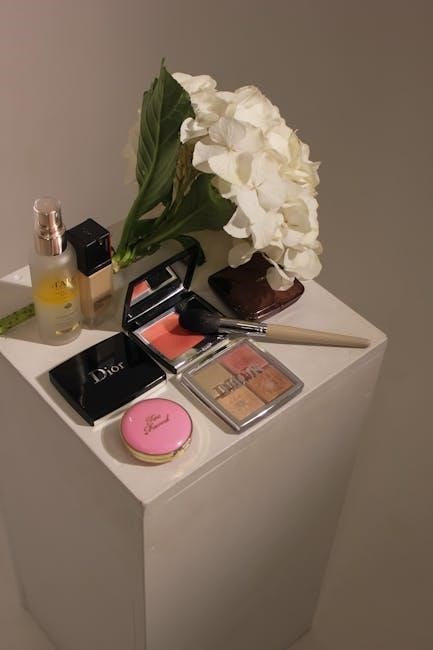
Setting Sprays for Eyeshadow
Setting sprays are a game-changer for ensuring long-lasting eyeshadow wear. These lightweight formulas lock in your look, preventing creasing and fading. Available in matte or dewy finishes, they refresh and rejuvenate makeup. For best results, hold the bottle 6-8 inches away and mist lightly over your lids. Choose a setting spray tailored to your skin type—hydrating for dry skin or oil-controlling for oily lids. By setting your eyeshadow, you maintain a flawless, professional finish all day. This simple step elevates your makeup routine, ensuring your eyeshadow stays vibrant and intact from morning to night, no matter the occasion or activity.

Eyeshadow Palette Guide
An eyeshadow palette is a must-have for versatile makeup looks, offering curated shades to enhance creativity and experimentation, perfect for both beginners and experienced beauty enthusiasts.
How to Choose the Right Palette
Selecting the right eyeshadow palette involves considering your skin tone, eye color, and personal style. Neutral shades are versatile and suit most looks, while bold colors add drama. Look for palettes with complementary tones that enhance your features. Matte finishes are great for natural looks, while shimmery shades add glamour. Assess the formula for pigmentation and blendability. Consider your budget and brand preferences, ensuring the palette offers variety for different occasions. Reading reviews and swatching before purchasing helps make the best choice. A well-chosen palette elevates your makeup routine, providing endless possibilities for creative expression and polished results.
Building Your Eyeshadow Collection
Building a versatile eyeshadow collection starts with essentials: neutral shades for everyday use and bold colors for special occasions. Invest in high-quality, multi-purpose palettes that offer a mix of finishes. Expand your range by adding unique or trendy shades seasonally. Consider your skin tone and eye color when selecting products to ensure they complement your features. Store your eyeshadows in a cool, dry place to maintain their quality. Over time, your collection will become a dynamic tool for creating countless looks, from subtle to dramatic, ensuring you’re always ready for any occasion.

Current Trends and Inspiration
Explore the latest eyeshadow trends, from vibrant hues to innovative techniques. Discover inspiration online through tutorials, influencer looks, and beauty communities to elevate your makeup style.
Latest Eyeshadow Trends
Current eyeshadow trends emphasize bold creativity and versatility. Glass skin finishes, multi-dimensional shimmer, and neon pops are dominating looks. Minimalist natural tones remain popular for everyday wear, while vibrant hues and cut crease techniques are trending for statement eyes. Smoky eyes have evolved with softer, blended transitions for a modern twist. Glitter and metallic shades are making a comeback, especially for evening events. Sustainability is also influencing choices, with eco-friendly palettes gaining traction. These trends offer endless possibilities, allowing individuals to express their unique style and adapt to any occasion seamlessly.
Where to Find Inspiration Online
Discovering eyeshadow inspiration online is effortless with platforms like Instagram, TikTok, and YouTube. Beauty influencers and makeup artists showcase trending looks and techniques. Pinterest offers visual boards for organizing favorite styles. Reddit’s beauty communities share tips and recommendations. Blogs and websites dedicated to makeup trends provide step-by-step guides. Additionally, brands often highlight their eyeshadow palettes with tutorials on their websites. Explore hashtags like #EyeshadowInspo or #MakeupTrends to uncover a wealth of creative ideas. Bookmarking or following expert accounts can help you stay updated and inspired to try new eyeshadow looks tailored to your preferences and skill level.


















